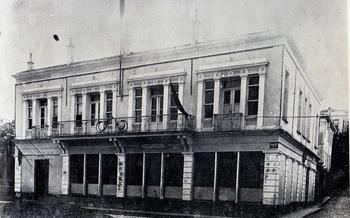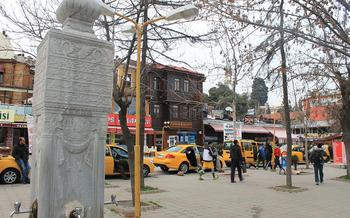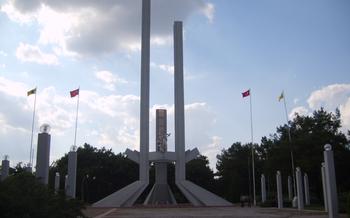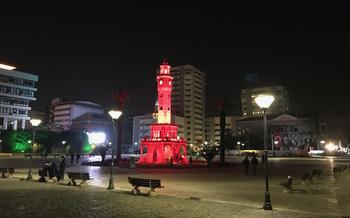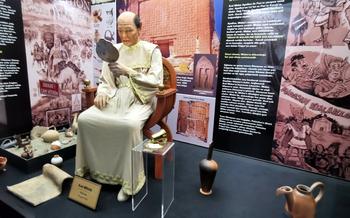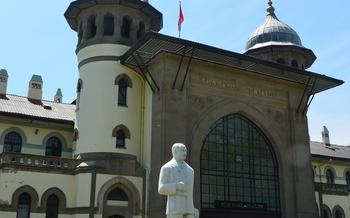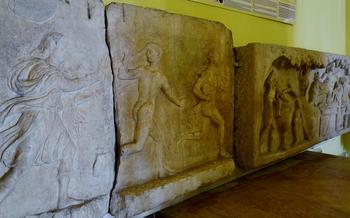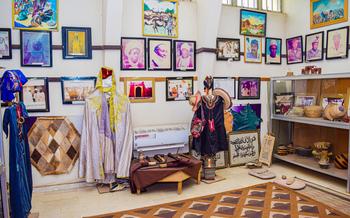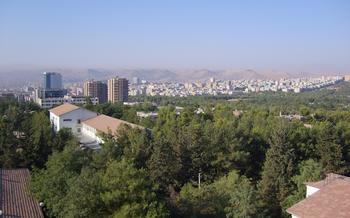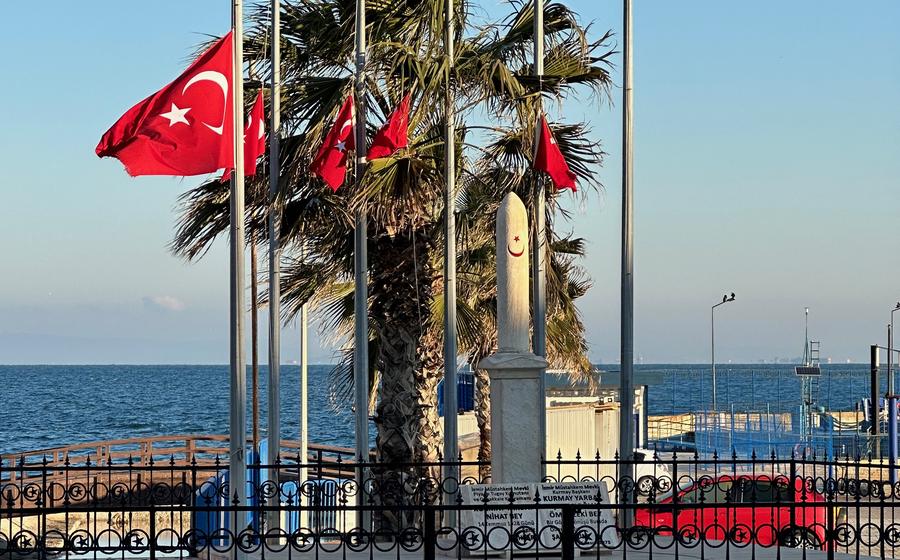
The Martyrdom Monuments
- The Martyrdom Monuments: Symbol of Resistance and Resilience
- Historical Background: Remembering the Turkish War of Independence
- Exploring the Monuments: A Journey Through History
- The Great Kahramanmaraş Resistance Museum: A Treasure Trove of History
- The Memorial Park: A Place for Reflection and Remembrance
- The Tomb of Sütçü İmam: A Symbol of Heroism and Sacrifice
- The Kahramanmaraş Resistance Monument: A Tribute to Unity and Courage
- The Liberation Monument: Celebrating Independence and Victory
- The Turkish Flag Monument: A Symbol of National Identity
- The Atatürk Monument: Honoring the Father of Modern Turkey
- The Martyrs' Cemetery: A Place of Honor and Remembrance
- Local Traditions and Commemorations: Honoring the Past
- Tourism and Historical Sites: Exploring the Region's Rich Past
- Insider Tip: Unveiling Hidden Gems
The Martyrdom Monuments: Symbol of Resistance and Resilience
The Martyrdom Monuments in Kahramanmaraş stand as a testament to the unwavering spirit of resistance and resilience that defined the Turkish War of Independence. These monuments, etched in stone and steel, serve as a poignant reminder of the sacrifices made by Turkish soldiers and civilians in their valiant struggle against foreign occupation.
Their architectural style echoes the determination and unity that characterized the Turkish people during this pivotal period in their history. Intricate carvings and symbolic motifs adorn these monuments, narrating the tales of heroism, bravery, and unwavering patriotism that shaped the course of the war.
The monuments not only commemorate the fallen but also celebrate the indomitable spirit of the Turkish nation. They symbolize the resilience of a people who refused to bow to adversity, standing firm in their resolve to protect their homeland and secure their independence.
Historical Background: Remembering the Turkish War of Independence
The Turkish War of Independence, also known as the National Struggle, was a pivotal event in Turkey's history that shaped the nation's identity and paved the way for its independence. The war, which took place from 1919 to 1923, was fought against the Allied powers, including France, Greece, Italy, and the United Kingdom, who sought to divide and occupy the Ottoman Empire following its defeat in World War I. Determined to resist foreign occupation and gain independence, the Turkish people, led by Mustafa Kemal Atatürk and his comrades, waged a heroic struggle against overwhelming odds.
Kahramanmaraş played a crucial role in the Turkish War of Independence. Strategically located in southeastern Turkey, the city became a hub of resistance against French forces who occupied the region. The people of Kahramanmaraş, fueled by a deep sense of patriotism and unity, fiercely resisted the French occupation and refused to bow to foreign rule. Local resistance groups, such as the "Kahramanmaraş Müdafaa-i Hukuk Cemiyeti" (Kahramanmaraş Defense of Rights Association), were formed to organize and coordinate the fight against the occupiers.
Kahramanmaraş became a symbol of Turkish resistance during the war. The city's unwavering determination and resilience in the face of adversity inspired the entire nation and played a significant role in galvanizing support for the independence movement. The sacrifices made by the people of Kahramanmaraş and their heroic struggle against the French occupation left an indelible mark on Turkish history and continue to be remembered and honored to this day.
Exploring the Monuments: A Journey Through History
Nestled within the heart of Kahramanmaraş, the Martyrdom Monuments stand as a testament to the city's indomitable spirit and the sacrifices made during the Turkish War of Independence. These monuments, each with its unique story to tell, offer visitors a poignant journey through history, allowing them to connect with the past and pay homage to the heroes who fought for Turkey's freedom.
Location and Accessibility:
The Martyrdom Monuments are conveniently situated in the city center of Kahramanmaraş, ensuring easy accessibility for visitors. Located within walking distance of various hotels, restaurants, and historical sites, the monuments form an integral part of the city's cultural and historical landscape.
Architectural Highlights and Notable Features:
As you approach the monuments, their striking architectural details and distinct features immediately captivate the eye. The use of local stone and intricate carvings adds a sense of authenticity and grandeur to these structures. Each monument boasts unique design elements, from the towering columns of the Martyrdom Monument to the intricate reliefs adorning the Great Kahramanmaraş Resistance Museum.
Commemorative Inscriptions and Symbols:
The monuments are adorned with commemorative inscriptions and symbols that pay tribute to the fallen soldiers and civilians who made the ultimate sacrifice. These inscriptions, etched in stone or metal, serve as a poignant reminder of their bravery and unwavering commitment to their homeland. The monuments are also adorned with various symbols, such as the Turkish flag, the crescent and star, and the emblem of the Turkish War of Independence, which serve as powerful reminders of the nation's struggle for freedom.
Stories Behind the Monuments:
Each monument holds a unique story, narrating the heroic deeds of individuals who played a pivotal role in the Turkish War of Independence. Visitors can learn about the valiant resistance of Sütçü İmam, the unity and determination symbolized by the Kahramanmaraş Resistance Monument, and the celebration of independence embodied by the Liberation Monument. These stories, passed down through generations, serve as a source of inspiration and pride for the Turkish people.
The Great Kahramanmaraş Resistance Museum: A Treasure Trove of History
Nestled in the heart of Kahramanmaraş, the Great Kahramanmaraş Resistance Museum stands as a testament to the city's indomitable spirit and its pivotal role in the Turkish War of Independence. This treasure trove of history houses a remarkable collection of artifacts, documents, and personal accounts that narrate the gripping story of the local resistance against foreign occupation.
Among the museum's most poignant exhibits are the tattered uniforms, worn weapons, and handwritten letters of Turkish soldiers and civilians who fought valiantly for their homeland. These tangible relics of a tumultuous era offer a glimpse into the sacrifices and hardships endured by the people of Kahramanmaraş.
The museum also features a section dedicated to the heroic resistance led by Sütçü İmam, a local dairyman who became a symbol of defiance against the French occupiers. His story of courage and unwavering determination is brought to life through interactive displays and multimedia presentations.
The Great Kahramanmaraş Resistance Museum serves as a crucial repository of knowledge and memory, ensuring that the legacy of the Turkish War of Independence and the bravery of its people are never forgotten. It is a must-visit destination for anyone seeking to delve deeper into the rich history of Kahramanmaraş and its pivotal role in shaping the destiny of Turkey.
The Memorial Park: A Place for Reflection and Remembrance
Amidst the bustling city of Kahramanmaraş lies a tranquil oasis dedicated to honoring the sacrifices made during the Turkish War of Independence: the Memorial Park. This serene space offers visitors a place for reflection, remembrance, and appreciation of the bravery and resilience of those who fought for their nation's freedom.
The park's tranquil ambiance invites visitors to stroll along its pathways, surrounded by lush greenery and the gentle sound of water features. Monuments and memorials dedicated to fallen soldiers stand as solemn reminders of the sacrifices made during the war. Each monument bears the names and stories of those who gave their lives for their country, evoking a sense of gratitude and respect.
Commemorative events and gatherings are frequently held in the park, bringing together the community to honor the memory of their fallen heroes. These events often feature speeches, prayers, and traditional ceremonies, creating a powerful sense of unity and remembrance.
The Memorial Park serves as a sanctuary for reflection and remembrance, providing a space for visitors to pay their respects to those who fought for their freedom. It is a place where the past is honored, and the sacrifices made by ordinary people are never forgotten.
The Tomb of Sütçü İmam: A Symbol of Heroism and Sacrifice
Among the many monuments and memorials dedicated to the heroes of the Turkish War of Independence, the Tomb of Sütçü İmam stands as a poignant reminder of the sacrifices made by ordinary citizens in the face of foreign occupation. Sütçü İmam, a local milkman, became a symbol of resistance when he single-handedly fought against French forces during the occupation of Kahramanmaraş. Despite being outnumbered and outgunned, he refused to surrender and fought valiantly until his tragic death.
His heroic stand inspired the people of Kahramanmaraş and beyond, becoming a symbol of the unyielding spirit of the Turkish nation. After the war, a tomb was erected in his honor, where locals and visitors alike pay their respects to this courageous hero. The tomb has become a place of pilgrimage for those who seek to honor his memory and draw inspiration from his unwavering patriotism.
Local traditions and rituals surrounding the tomb further underscore the significance of Sütçü İmam's legacy. Every year, on the anniversary of his death, a commemorative ceremony is held at the tomb, where people from all walks of life gather to remember his bravery and pay their respects. These traditions not only honor Sütçü İmam's sacrifice but also serve as a reminder of the collective struggle for freedom and independence that defined the Turkish War of Independence.
The Kahramanmaraş Resistance Monument: A Tribute to Unity and Courage
Among the poignant monuments in Kahramanmaraş, the Kahramanmaraş Resistance Monument stands as a powerful tribute to the unity and courage displayed by the Turkish people during the war. Located in the heart of the city, this impressive monument depicts a group of Turkish soldiers united under a single banner, their expressions filled with determination and resilience. The monument symbolizes the unwavering spirit of the Turkish nation, standing together against all odds.
The monument's design is a testament to the strength and unity of the Turkish people. Its central figure, a towering soldier breaking free from chains, represents the nation's liberation from foreign occupation. The surrounding figures, each representing different aspects of Turkish society, stand shoulder to shoulder, conveying the sense of unity and cooperation that defined the resistance.
This monument serves as a reminder of the sacrifices made by countless individuals who fought for Turkey's independence. It is a source of inspiration and national pride, honoring the bravery and resilience of the Turkish people. Visitors to Kahramanmaraş are encouraged to visit the monument and pay their respects to the heroes who fought for their freedom.
The Liberation Monument: Celebrating Independence and Victory
Amidst the serene landscapes of Kahramanmaraş, the Liberation Monument stands tall, a testament to the unwavering spirit of the Turkish people. This awe-inspiring structure, erected in commemoration of the Turkish War of Independence, captures the essence of a nation breaking free from the shackles of foreign occupation. The monument's design is a poignant portrayal of Turkish soldiers, their bodies bursting forth from chains that once held them captive, symbolizing the triumph of freedom and independence.
As visitors approach the Liberation Monument, they are greeted by a surge of emotions. The monument's powerful imagery evokes a sense of pride and admiration for the sacrifices made by the Turkish people during their struggle for liberation. The monument serves as a reminder of the indomitable spirit that fueled the Turkish resistance, leading to the establishment of a sovereign and independent nation.
Beyond its historical significance, the Liberation Monument plays a vital role in fostering a sense of national unity among the Turkish people. It stands as a symbol of the collective will and determination that guided the nation through its darkest hours. The monument's presence serves as a constant reminder of the importance of unity and cooperation in the face of adversity, inspiring future generations to uphold the values of freedom and independence.
The Turkish Flag Monument: A Symbol of National Identity
Amidst the array of monuments in Kahramanmaraş, the Turkish Flag Monument stands tall as a powerful symbol of national identity. This awe-inspiring structure is a testament to the Turkish people's unwavering dedication to their homeland and their unwavering determination to uphold its sovereignty.
The monument's grandeur is a reflection of the significance it holds for the Turkish nation. Its towering height and imposing presence command attention, evoking a sense of pride and patriotism in the hearts of those who behold it. The monument's design is a masterpiece of simplicity and elegance, featuring a colossal Turkish flag that flutters majestically in the wind.
The flag, with its vibrant colors and crescent-star emblem, is a symbol of unity, strength, and resilience. It represents the rich history, cultural heritage, and indomitable spirit of the Turkish people. The monument serves as a constant reminder of the sacrifices made by countless individuals who fought valiantly to defend their nation and preserve its independence.
Standing proudly in the heart of Kahramanmaraş, the Turkish Flag Monument is a beacon of national pride and a source of inspiration for generations to come. It is a reminder of the importance of unity, patriotism, and the unwavering commitment to the preservation of national identity.
The Atatürk Monument: Honoring the Father of Modern Turkey
Amidst the array of monuments and memorials commemorating the Turkish War of Independence, the Atatürk Monument stands as a symbol of respect and admiration for Mustafa Kemal Atatürk, the revered founder of the Republic of Turkey and a pivotal figure in the country's history. The monument, a testament to Atatürk's legacy, captures his indomitable spirit and unwavering dedication to the nation's independence and modernization.
Etched in stone and bronze, the monument depicts Atatürk in his military uniform, his gaze resolute and determined, reflecting his pivotal role in leading the Turkish people to victory during the war. The monument's design evokes a sense of strength and purpose, embodying Atatürk's vision for a modern and progressive Turkey.
Beyond its artistic merit, the Atatürk Monument holds immense historical significance. It serves as a constant reminder of Atatürk's tireless efforts to transform Turkey into a thriving nation, free from foreign influence and committed to self-determination. His leadership and reforms laid the foundation for a secular and democratic Turkey, ushering in an era of progress and development.
Visiting the Atatürk Monument is a profound experience that allows visitors to connect with the spirit of a remarkable leader who left an indelible mark on Turkey's history. It is a place to reflect on his vision, his sacrifices, and the enduring impact of his legacy, which continues to inspire generations of Turks and shape the nation's identity.
The Martyrs' Cemetery: A Place of Honor and Remembrance
Located in the heart of Kahramanmaraş, the Martyrs' Cemetery stands as a solemn tribute to the brave soldiers and civilians who laid down their lives during the Turkish War of Independence. This sacred ground is a poignant reminder of the sacrifices made by those who fought for the nation's freedom and sovereignty.
The cemetery is meticulously maintained, with rows of white headstones adorned with the names, ranks, and dates of death of the fallen heroes. Each headstone bears witness to the immense loss and sacrifice endured by the Turkish people during the war.
Every year, on the anniversary of the Turkish War of Independence, commemorative events and ceremonies are held at the Martyrs' Cemetery. These gatherings bring together families, veterans, and local residents to honor the memory of those who made the ultimate sacrifice.
The Martyrs' Cemetery is not merely a burial ground; it is a place of profound respect, gratitude, and remembrance. It serves as a constant reminder of the debt owed to those who fought for the nation's independence and a symbol of the enduring spirit of the Turkish people.
Local Traditions and Commemorations: Honoring the Past
Kahramanmaraş holds the memory of the Turkish War of Independence close to its heart, and this is reflected in the local traditions and commemorations that honor the past. Every year, on the anniversary of the city's liberation, a grand ceremony is held at the The Martyrdom Monuments, where wreaths are laid, speeches are given, and prayers are recited to remember the sacrifices made by the Turkish soldiers and civilians. The local community participates with great enthusiasm, paying their respects to the martyrs who fought for their freedom.
Other traditional events include reenactments of historical battles, folk songs and dances that narrate the stories of heroism, and exhibitions showcasing artifacts from the war. These events serve as a reminder of the resilience and determination of the Turkish people during those challenging times. By participating in these traditions, the community not only honors the memory of their ancestors but also fosters a sense of unity and national pride.
Local artisans also play a role in preserving the legacy of the war through their crafts. They create traditional handicrafts, such as rugs, pottery, and jewelry, that depict scenes from the war or feature symbols of resistance. These handmade items are not only beautiful but also serve as a tangible reminder of the sacrifices made by the martyrs.
Tourism and Historical Sites: Exploring the Region's Rich Past
Kahramanmaraş is not only home to the Martyrdom Monuments but also a treasure trove of other historical sites and landmarks that offer a glimpse into the region's rich past. History buffs and travelers seeking cultural immersion will find plenty to explore in this captivating city.
One must-visit attraction is the Kahramanmaraş Castle, an ancient fortress that has witnessed centuries of history. Its imposing walls and towers offer panoramic views of the city, while its well-preserved structures provide a glimpse into the architectural heritage of the region.
Another notable site is the Kahramanmaraş Archaeological Museum, which houses a vast collection of artifacts from different periods of history. From ancient pottery and sculptures to rare coins and manuscripts, the museum offers a fascinating journey through the region's past.
For those interested in religious history, the Grand Mosque of Kahramanmaraş is a must-visit. This architectural marvel boasts intricate tilework, elegant domes, and a serene courtyard, reflecting the city's rich Islamic heritage.
Beyond the city center, the region surrounding Kahramanmaraş is dotted with numerous historical sites, including ancient ruins, medieval villages, and historic bridges. These hidden gems offer a unique opportunity to explore the region's diverse cultural heritage and immerse oneself in its timeless charm.
To make the most of your historical journey, consider engaging with local tour guides who can provide insights into the region's history, culture, and traditions. They can lead you to lesser-known sites, share captivating stories, and help you connect with the local community.
Remember to approach historical sites with respect and care. Avoid touching or damaging artifacts, and be mindful of local customs and traditions. Responsible tourism helps preserve these precious sites for future generations to appreciate and enjoy.
Insider Tip: Unveiling Hidden Gems
Beyond the well-known monuments, Kahramanmaraş holds a treasure trove of hidden gems that offer a deeper Einblick into the region's rich history. Venture off the beaten path to discover lesser-known monuments and sites that tell compelling stories of resistance and resilience. Explore the Old City's hidden courtyards, where you'll find historic buildings and remnants of the past. Seek out the small museums and cultural centers that showcase local perspectives and personal accounts of the Turkish War of Independence. Engage with the friendly locals, who are always willing to share their stories and insights. By immersing yourself in the community, you'll gain a deeper understanding of the region's history and the indomitable spirit of its people. Remember to approach these hidden gems with respect and sensitivity, as they are part of a living heritage that deserves to be preserved for generations to come.
